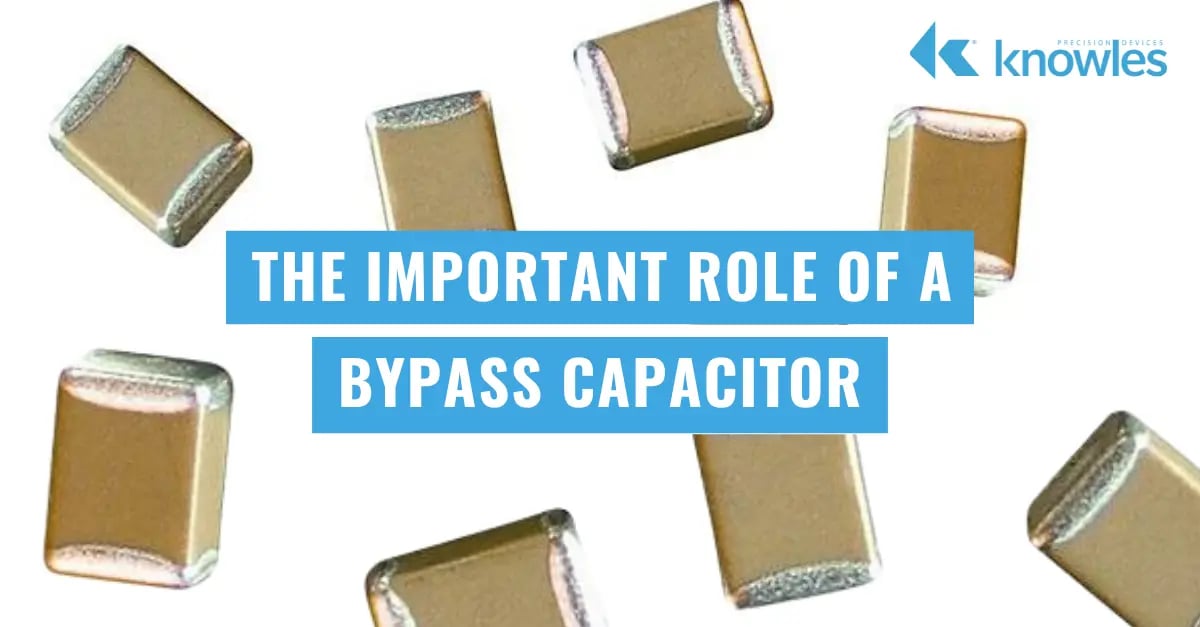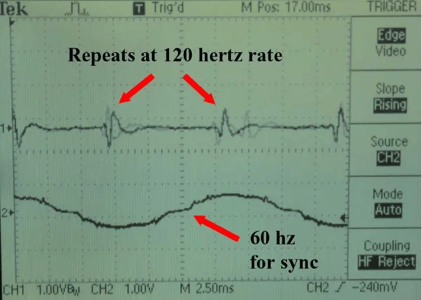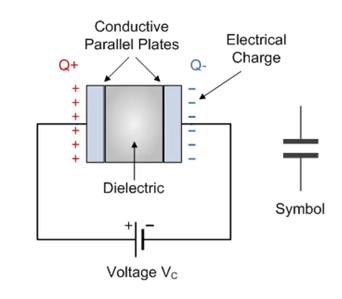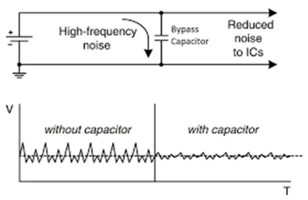Electronic devices provide the tools we need to power the world. From cell phones to modern vehicles to scientific equipment to the appliances in our homes, we rely on electronics to improve and even lengthen our lives. All electronics depend on clean power, and the bypass capacitor is crucial in ensuring devices safely meet their power specifications.

Why are Bypass Capacitors Necessary?
Every electronic system has the potential to be affected by electromagnetic interference (EMI). EMI can be induced from multiple human-causes or naturally occurring sources, such as:
- Power Line Emissions
- Radio Transmitters
- Electric Motors
- Relays
- Electrostatic Discharge (ESD)
- Lightning
Each source can couple with power and signal traces in a design, introducing noise into the design. Even with careful layout considerations, any DC power line can act as an inductor that absorbs and transmits electromagnetic fields. Figure 1 shows a common scenario in which household 60 Hz power induces power glitches on a DC power line.

Figure 1. 60 Hz-induced EMI on a DC line. Source.
The quality of the power provided is reduced when these emissions are loaded on top of the desired steady-state DC voltage. Some potential EMI-induced failure modes range from single-bit flips and glitches that robust hardware and software solutions are designed to correct to integrated circuit (IC) latch-up, forcing a system reset. Large ESD spikes may cause total IC failure.
How a Bypass Capacitor Mitigates EMI
A capacitor is a passive electronic device consisting of two conductive plates separated by a dielectric, as shown in Figure 2. Once power is applied, the capacitor stores energy on the plates until it reaches equilibrium with the supplied voltage. If an outside event causes a low voltage on the supply line, the capacitor feeds its stored charge back onto the line. If an overvoltage event occurs, the excess crosses the dielectric and shunts to ground.

Figure 2. Capacitor physical diagram. Source.
To ensure that expensive, high-speed components are provided with clean power consistently, designers add bypass capacitors as close to the IC power input leads as possible. The bypass capacitor acts as a filter, providing infinite resistance to steady-state voltage and bypassing high-frequency noise. This attenuates noise on the power line, as shown in Figure 3.

Figure 3. Circuit diagram and resulting trace.
The ability of a capacitor to filter high-frequency signals can be tuned according to the capacitive reactance formula:
Xc = 1 / (2 * π * f * C)
Where Xc is the capacitive reactance in ohms, f is the frequency in hertz, and C is the capacitance of the capacitor in farads. At low frequencies (e.g., DC power), the capacitive reactance approaches infinity, acting like an open circuit that allows the DC line voltage to power the targeted device. High-frequency noise on the line passes through to ground. Capacitors can be chosen to inhibit specific frequencies by solving for f in the equation, assuming a suitably high resistance value.
The components of the capacitor manufacture, such as leads, add resistance and inductance to the devices. These are known, respectively, as equivalent series resistance (ESR) and equivalent series inductance (ESL). Careful consideration of the capacitor design ensures low ESR and ESL values.
How Bypass Capacitors Improve Reliability in Electronic Systems
Beyond providing clean power to ICs, bypass capacitors play a critical role in many fields of electronics. Because bypass capacitors reduce noise and stabilize the power to the design, the following systems see noticeable benefits as listed:
- Audio amplifiers achieve reduced distortion and improved audio quality
- WiFi receivers and transmitters improve signal reception and transmission, allowing higher data transfer rates
- MRI imaging RF pulse generators deliver accurate and precise pulses
- Analog-to-digital converters (ADCs) attain improved conversion accuracy
- Microcontrollers encounter fewer errors resulting in enhanced reliability and performance
- LED lighting systems provide improved lighting quality and reduced visual discomfort
Each of these systems exhibit unique vulnerabilities to specific bands and frequencies of EMI. Bypass capacitors, in conjunction with shielding and layout considerations, can be specifically chosen to limit EMI in problematic areas of the design.
How Knowles Precision Devices Can Help
Increasingly, devices need to be designed to maintain electromagnetic compatibility (EMC), which means devices will not emit or receive electromagnetic energy causing EMI. Knowles Precision Devices carries a wide array of multilayer ceramic capacitors (MLCCs) that can meet these rigorous standards for your product designs. When you have a specific problem to tackle, we can help you select or design the bypass capacitor solution for your system.
Our MLCCs exhibit excellent high-frequency performance and can be tuned to filter out specific bands. Our capacitors are designed with very low ESL and ESR, and new layer topology and packaging methods have significantly improved insertion loss performance. Compared to other capacitor manufacturing materials, like films, ceramic devices operate across a wide range of temperatures without significant degradation while maintaining high stability. Systems designed with our MLCCs, such as our line of X7R capacitors, ensure a lifetime of consistent performance, even in harsh environments.
Whether you’re designing for defense systems that require conforming to various MIL-SPECs, or medical devices regulated by the Food and Drug Administration’s Quality System Regulation (QSR), we can work with you to rigorously test components to meet or exceed these standards.

